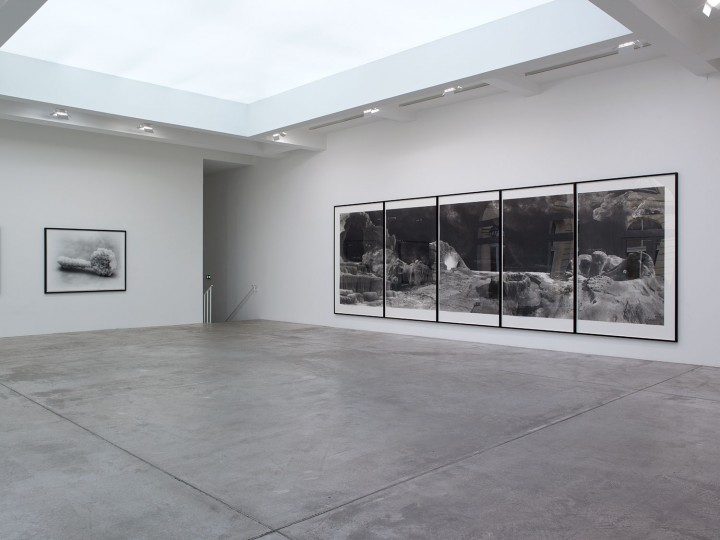In 1997 Tacita Dean recorded her trip to find Robert Smithson’s Spiral Jetty (1970), using a tape recorder and a 35mm stills camera. By failing to find Smithson’s work after following a set of instructions faxed by the Utah Arts Council she decided to produce a sound recording of her trip (Trying To Find The Spiral Jetty, 1997), and an installation projection of her 35mm slides (Rozel Point, Great Salt Lake, Utah, 1999). J.G. Ballard heard about the pieces, and sent to Dean a short text he had written on Smithson. Dean and Ballard subsequently began to correspond about the Spiral Jetty. This discussion culminated when Ballard declared in 2009 that she should “treat the Spiral Jetty as a mystery her film would solve”.
Thus Dean recorded the now visible jetty in JG (2013), her looped 35mm anamorphic film shot on location in the salt-encrusted landscapes of Utah and southern California. The film is inspired by Dean’s correspondence with Ballard regarding the connections between the Spiral Jetty and his short story, The Voices of Time (1960) which ends with the scientist Powers building a cement mandala – a “gigantic cipher” – in the dried-up bed of a salt lake “in a place that feels, by description, to be on the very borders of civilisation: a cosmic clock counting down our human time », Dean says. This concept of time and the repetition of visual and thematic elements in different levels are constant preoccupations in Smithson, Dean and Ballard’s work. For the author Smithson’s jetty could be an elaborate cargo to bore down to get into an ancient universe beneath the Great Salt Lake. This cargo is a time-machine. Thus Dean likens the spiral of the jetty and the spiral nebulae in The Voices of Time to the spiral of her analogue film loop – as Smithson noted, “a film is a spiral made up of frames”.
JG was elaborated upon a technique for which Dean shoots and reshoots lengths of film using selective masking to create a collage of different elements within a single frame: “Exposing light through the aperture gate is what makes the frame on film which, of course, is otherwise blank. So by masking inside the aperture, you can make different shapes, almost like stencilling,” Dean says. With these masks she uses a range of abstract and organic forms that suggest mountains or planets and the Spiral Jetty appears to be traced by hand. She mixes different landscapes and times in the same frame: the time of prehistoric land, of Smithson’s work, of Ballard’s novel, of early artisanal film production and of present time.
JG is screened in a continuous loop in the basement of the Marian Goodman gallery and eclipse the body of works presented on the ground floor. Each of them are related to salt lakes landscapes: a group of 14 photographs from the film (with sprocket holes of a strip of 35mm Ektachrome slide film, a symbol of Ballard’s 35mm camera, which was donated to Dean by Claire Walsh, the author’s longtime Partner), seven found postcards with gouache and three salinated balls, two photographs of a salinated book and a film spool cover by crystals salt, and Quatemary (2014) a large scale photogravure in five parts depicting a black and white landscape made by deserts and caves images.



